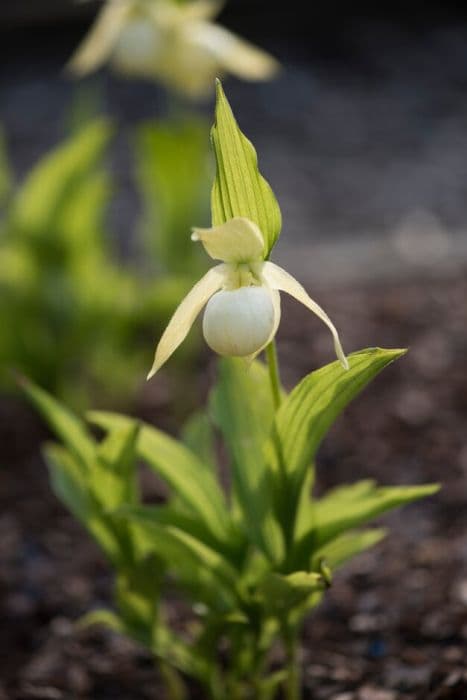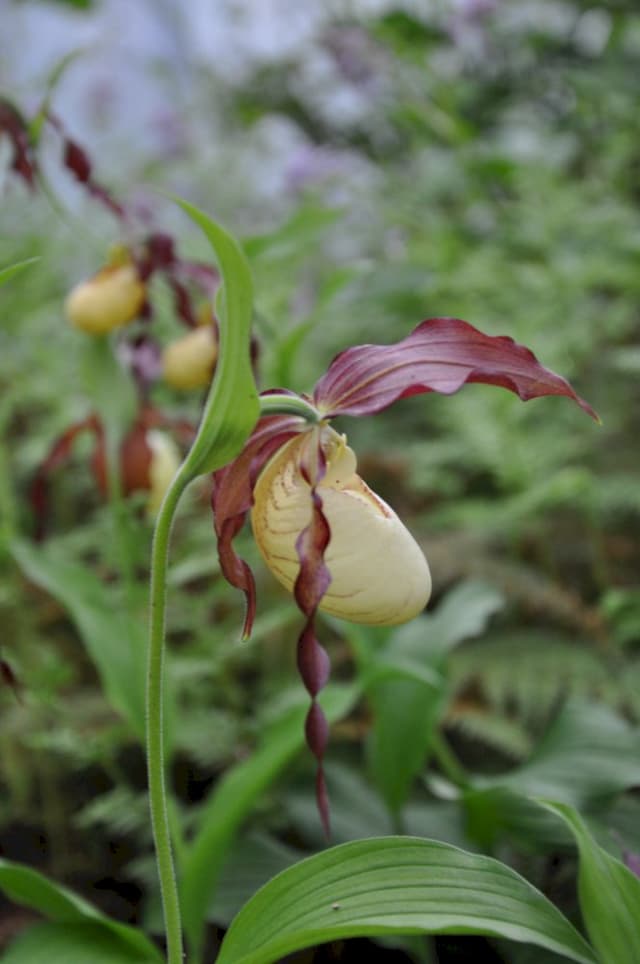Formosan lady's slipper Cypripedium formosanum

ABOUT
The plant commonly known as the Formosa lady's slipper orchid is a captivating and beautiful perennial that exhibits a striking appeal. The plant has a distinctive flower which is typically characterized by a large, slipper-shaped pouch. This pouch is often a light pink or white hue with darker pink or purple spots and stripes. Surrounding the pouch, there are several petals and sepals that can vary in color but commonly mimic the coloration of the pouch with contrasting veins or stripes. The leaves of the Formosa lady's slipper orchid are equally attractive, with a rich, deep green color. They are typically elongated with a pleated appearance, which gives them an accordion-like texture. The foliage's lushness provides an elegant backdrop to the spectacular blossoms which typically emerge singularly from each stem. The overall allure of the Formosa lady's slipper orchid comes from its intricate flower structure and the harmonious contrast of its colors, making it a prized specimen for orchid enthusiasts and a delightful addition to shade gardens where it can thrive under the right conditions.
About this plant
 Names
NamesFamily
Orchidaceae
Synonyms
Formosan Lady's Slipper, Taiwanese Lady's Slipper, Beautiful Cypripedium
Common names
Cypripedium formosanum
 Toxicity
ToxicityTo humans
The plant commonly known as the Taiwan Lady's Slipper (Cypripedium formosanum) is not generally considered toxic to humans. There are no well-documented cases of poisoning or toxic effects from ingesting parts of this particular orchid. While it is not advisable to consume any part of ornamental plants without proper knowledge, there are no specific reports of this species causing harm if accidentally ingested.
To pets
Similar to its effect on humans, the Taiwan Lady's Slipper (Cypripedium formosanum) is not widely recognized as a toxic plant to pets either. There are no significant reports of toxicity in domestic animals following ingestion of this orchid. However, as with all non-food plants, it is always best to prevent pets from consuming them to avoid any potential for gastrointestinal upset or other unforeseen reactions.
 Characteristics
CharacteristicsLife cycle
Perennials
Foliage type
Deciduous
Color of leaves
Green
Flower color
Pink
Height
1 feet 4 inches (40 cm)
Spread
1 feet (30 cm)
Plant type
Herb
Hardiness zones
6
Native area
Taiwan
Benefits
 General Benefits
General Benefits- Ornamental Value: Cypripedium formosanum, commonly known as Formosa's lady's slipper, is prized for its unique and attractive flowers, making it a popular ornamental plant.
- Habitat Support: It provides a natural food source and habitat for various insects, especially specific bees that are attracted to its flowers for pollination.
- Biodiversity: By cultivating Cypripedium formosanum, gardeners can contribute to biodiversity, as it adds a rare and distinct species to the environment.
- Education and Research: This plant can be used for educational purposes, allowing students and researchers to study its unique botanical characteristics and pollination biology.
- Conservation: Growing Formosa's lady's slipper can help in the conservation of the species, especially as it may be rare or threatened in its natural habitat.
- Cultural Significance: In some cultures, Cypripedium formosanum has cultural importance and is used in traditional rituals or as a symbol in art and literature.
 Medical Properties
Medical Properties- Analgesic: Used traditionally to reduce pain or discomfort.
- Antispasmodic: May help relieve muscle spasms or cramps.
- Sedative: Utilized for its potential calming effects or to aid in sleep.
 Air-purifying Qualities
Air-purifying QualitiesThis plant is not specifically known for air purifying qualities.
 Other Uses
Other Uses- Ornamental Display: The visually striking appearance of the Cypripedium formosanum, commonly known as the Formosan lady's slipper, makes it highly valued for display in ornamental gardens and botanical collections.
- Educational Tool: Botany and horticulture students can study the Formosan lady's slipper as an example of symbiotic relationships between orchids and mycorrhizal fungi.
- Photography Subject: Due to its unique and exotic look, photographers may use the Formosan lady's slipper as a captivating subject for nature and macro photography.
- Conservation Emblem: This plant could serve as a symbol for conservation efforts aimed at preserving native orchid species and their habitats.
- Cultural Significance: In regions where it is native, the Formosan lady's slipper may play a role in cultural traditions and be featured in art and folklore.
- Biodiversity Indicator: As a part of the ecosystem, its presence and health can indicate the overall state of biodiversity in certain forest systems.
- Floristry: The Formosan lady's slipper might be used in specialty floral arrangements and displays, although care should be taken to ensure sustainability due to its often protected status.
- Collectors' Item: Orchid enthusiasts often seek rare and beautiful specimens like the Formosan lady's slipper to add to their private collections.
- Garden Design: This orchid can be used as a striking focal point in shade garden design, adding an exotic flair to landscaped areas.
- Green Gifts: Eco-conscious consumers might favor giving the Formosan lady's slipper as a sustainable and environmentally friendly gift option.
Interesting Facts
 Feng Shui
Feng ShuiThe Cypripedium formosanum, commonly known as the Formosa lady's slipper, is not used in Feng Shui practice.
 Zodiac Sign Compitability
Zodiac Sign CompitabilityThe Formosa lady's slipper is not used in astrology practice.
 Plant Symbolism
Plant Symbolism- Beauty: The Cypripedium formosanum, commonly known as the Formosa Lady's Slipper, is renowned for its striking and exotic blooms, symbolizing an exceptional and rare beauty.
- Femininity: With its slipper-shaped petals reminiscent of a woman's shoe, this orchid often represents feminine grace and elegance.
- Refinement: The delicate and intricate structure of the Formosa Lady's Slipper suggests sophistication and a refined taste, often associated with luxury and exclusivity.
- Unique Identity: As an orchid with a distinct appearance, it symbolizes the celebration of one's unique qualities and individuality.
- Captivity: Due to the rarity and specific growing requirements, it can also represent something precious that is difficult to attain or keep, like a treasure that is both sought after and protected.
 Water
WaterFor the Taiwanese Lady's Slipper, ensure the soil is kept evenly moist but not waterlogged by watering every five to seven days, depending on the humidity and temperature of your environment. Use about 8 to 16 ounces of water each time or until the water runs freely through the drainage holes, adjusting the amount as the seasons change. During the active growth period in spring and summer, they may require more frequent watering. Reduce watering during the dormant period in the fall and winter, allowing the top inch of the soil to dry out slightly between waterings.
 Light
LightThe Taiwanese Lady's Slipper prefers bright, indirect light and should be placed in a spot where it can receive filtered sunlight, like a north-facing window or a shaded east or west-facing window. Avoid direct sunlight, especially during the hot afternoon hours, as it can scorch the leaves and negatively affect the plant's health. The ideal lighting condition provides a soft, dappled shade akin to its natural woodland habitat.
 Temperature
TemperatureThe Taiwanese Lady's Slipper thrives in temperatures between 50 and 75 degrees Fahrenheit. They can tolerate a minimum temperature of around 40 degrees Fahrenheit but should not be exposed to freezing conditions. The ideal temperature range promotes healthy growth and flowering; ensure that temperature fluctuations are minimized to avoid stressing the plant.
 Pruning
PruningPruning the Taiwanese Lady's Slipper is primarily to remove dead or damaged foliage, which can be done at any time of year as needed. Carefully trim away the affected parts with sterile scissors to prevent the spread of disease. Pruning is also done after flowering, typically in the late summer or fall when the plant begins to enter dormancy. This helps encourage new growth in the next season.
 Cleaning
CleaningAs needed
 Soil
SoilThe Taiwanese Lady's Slipper Orchid thrives in a soil mix that is well-draining and rich in organic matter. A suitable recipe would be a blend of two parts fine bark, one part perlite, and one part peat with a pH around 5.5 to 6.5, ensuring that the soil is slightly acidic.
 Repotting
RepottingTaiwanese Lady's Slipper Orchids should be repotted every one to two years, preferably in the spring after flowering. This frequency prevents soil compaction and allows for fresh nutrients to support growth.
 Humidity & Misting
Humidity & MistingTaiwanese Lady's Slipper Orchids prefer high humidity levels, around 40% to 70%. Consistently high humidity is vital for their growth but should not be accompanied by stagnant air which could invite fungal infections.
 Suitable locations
Suitable locationsIndoor
Ensure good light, high humidity, and cool temps for indoor growing.
Outdoor
Plant in dappled shade with moist soil and protect from harsh weather.
Hardiness zone
6-9 USDA.
 Life cycle
Life cycleCypripedium formosanum, commonly known as the Formosa lady's slipper, initiates its life cycle when a seed germinates, but unlike many plants, it requires a mycorrhizal fungus to provide essential nutrients for initial growth. The seedling develops into a small protocorm, an underground structure, which later gives rise to the first leaves and roots. As the plant matures, it forms a rhizome that can give rise to new shoots annually. The Formosa lady's slipper produces distinctive flowers typically in the spring, which are pollinated by insects attracted to its color and form. After pollination, the plant develops a seed capsule containing numerous tiny seeds that are dispersed by wind. Over time, these seeds may germinate in a suitable environment, perpetuating the life cycle of this perennial orchid.
 Propogation
PropogationPropogation time
Spring-Early Summer
The Taiwanese Lady's Slipper Orchid, Cypripedium formosanum, is best propagated through division, which is typically done in late summer or early fall after the plant has finished flowering and when it is somewhat dormant. To propagate by division, you would gently lift the plant from the soil, ensuring you have a healthy section of rhizome with at least one growing point, commonly known as an "eye." This piece of rhizome can then be planted in a well-draining medium, ideally with a mixture of fir bark, perlite, and peat moss to mimic its natural growing conditions. It should be placed at a depth where the top of the rhizome is just below the surface of the medium, and then watered lightly to settle the plant into its new home. It is crucial to maintain high humidity around the plant and to keep it in a cool, shaded spot until new growth appears, which indicates successful propagation.









